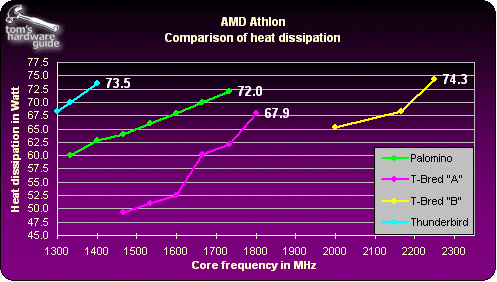AMD Travels Through Time: Athlon XP 2800+ with Dual-DDR
Comparison: Heat Dissipation Of All AMD Athlon CPUs
The following graphic lists the thermal dissipation of all Athlon CPUs starting from 1300 MHz, from the Athlon with the Thunderbird core, to the Palomino, up through the two Thoroughbred "A" and "B" cores. Apparently, switching over to the 0.13 micron technique only briefly puts a damper on the rise in thermal power loss. As opposed to the earlier assumptions from AMD, the record value for the thermal power loss has risen to new heights: 74.3 Watt with the Athlon XP 2800+. This surpasses that old power station block in ceramic casing, the Athlon 1400 with 73.5 Watt.
Bingo! Synchronous Operation With 166 MHz FSB
Synchronous mode is available: 166 MHz FSB with the Asus A7N8X and the nForce 2 chipset.
AMD hit the jackpot with its increased FSB clock speed of 166 MHz. Up to now, the Front Side Bus ran at 133 MHz (double data rate) between the Athlon CPU and the Northbridge of the chipset, achieving a bandwidth of 2.1 GB/s. Together with DDR266 memory (VIA KT266 and VIA KT266A), the RAM also reached a bandwidth of 2.1 GB/s at a clock speed of 133 MHz. Here, both of the buses work synchronously and are optimally tuned to one another.
Following this, there was a change in the RAM: modules with DDR333 now ran with 166 MHz and offered a bandwidth of 2.6 GB/s. The appropriate chipsets came from VIA (KT333 and KT400) and had to make do with asynchronous operation, since the Athlon XP at the time could still only run with 133 MHz FSB. Note that VIA's KT333 with 166 MHz FSB support was already launched on February 20, 2002 (DDR333 For Athlon: VIA KT333 vs. KT266A ).
Get Tom's Hardware's best news and in-depth reviews, straight to your inbox.
Current page: Comparison: Heat Dissipation Of All AMD Athlon CPUs
Prev Page Details On The Athlon XP 2800+/2700+ Next Page Bingo! Synchronous Operation With 166 MHz FSB, Continued

